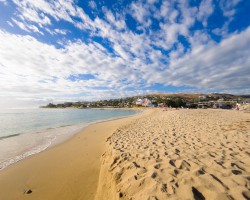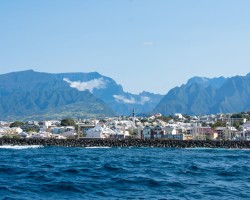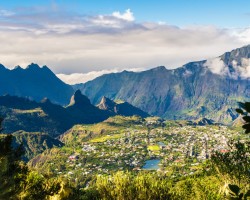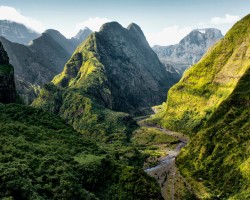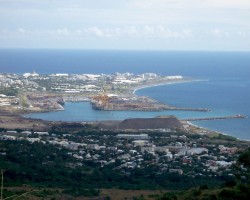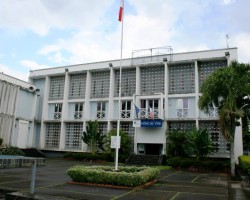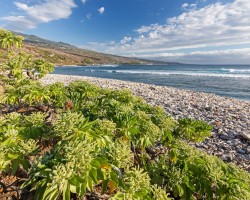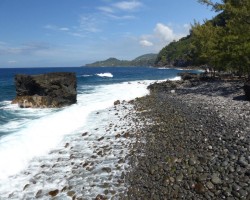Best time to go to Reunion Island for a perfect weather and where to go?
When is the best time to go to Reunion Island?
The best time to visit Reunion Island is undoubtedly the dry season which runs from May to November.
This period is characterized by mild heat perfect for outdoor activities. It is the ideal time to enjoy the beaches of the island, but also to hike in the mountains. During the dry season, the sun is often shining, and precipitation is rare.
July and August are the months with the highest tourist influx. The stunning beaches on the west side of the island attract many vacationers from Europe. If you are wondering when to visit Reunion to avoid the crowds, know that the months of May, June, September, and October are equally pleasant but less crowded.
On the other hand, if rainy episodes do not bother you, it is also possible to travel to Reunion during the wet season. Many travelers especially prefer the end of the year for their stay. However, from November to May, the heat can sometimes reach 40°C (104°F) , which can be challenging. Moreover, rainy days are frequent, and it can rain for several hours.
The wet season is nevertheless a good time to attend local festivities such as the Chinese and Tamil New Year, fire-walking ceremonies, or the numerous trails that take place during this period.
Where and when to go based on the weather?
Central Mountains of Reunion
Cilaos, Salazie, La Plaine des Palmistes...
East of Reunion
Saint-Benoît, Sainte-Rose (Reunion), Bras-Panon...
North of Reunion
Saint-Denis, Sainte-Suzanne, Saint-André...
South of Reunion
Saint-Pierre, Saint-Philippe, L’Étang-Salé...
West of Reunion
Saint-Gilles-les-Bains, Saint-Leu, Le Port...
To get all the information about the climate and weather on the island of Reunion for a specific month, click on the corresponding link below:
Reunion in january Reunion in february Reunion in march Reunion in april Reunion in may Reunion in june Reunion in july Reunion in august Reunion in september Reunion in october Reunion in november Reunion in december
Best time to travel to Reunion by cities





































Climate and Weather on the island of Reunion
Located near Mauritius and Madagascar, Reunion benefits from a tropical climate. The island enjoys a constant warmth with average temperatures ranging between 20 and 30°C (86°F) . Reunion's climate is also characterized by frequent showers.
Situated in the southern hemisphere, Reunion experiences reversed seasons compared to mainland France. In fact, there are two seasons:
- southern winter, from May to November, with pleasant temperatures, sunny weather, and rare showers
- southern summer, from November to April, characterized by more frequent rains and high temperatures (read: visiting Reunion during the rainy season).
Moreover, Reunion has a lot of relief, including a peak at 3069 meters above sea level. As a result, there are significant climate variations on the island. Indeed, the weather is warmer on the coasts and cooler further inland.
Additionally, there is a more sheltered area from the winds: the west coast, towards Saint-Paul, is known as "the leeward coast," while the east coast, towards Sainte-Rose, is called "the windward coast." Consequently, it rains more often in the east of the island than in the west.
Reunion experiences a cyclone season from November to May. The island can be affected by tropical cyclones that sometimes cause damage to the coasts. However, it is mainly the severe weather conditions that make this period challenging, bringing torrential rains and strong winds.

It is interesting to know more about the climate of Reunion region by region in order to plan your trip.
Climate in the north and west of Reunion
The north and west of the island have a relatively pleasant climate, making it a very touristy region.
Indeed, this is where the capital of Reunion, Saint-Denis, is located on the north coast. In this area, there are approximately 1,600 mm of rainfall per year, mostly occurring during the months of January, February, and March. Temperatures average 25 °C during the dry season and can drop to 15°C (59°F) at night. In summer, however, temperatures range between 30 and 23°C (74°F) depending on the time of day.
Furthermore, the further west you go, the more pleasant the weather becomes. For example, in Saint Paul and Saint Leu, there are around 1300 mm of precipitation per year. These rains are concentrated in the wet season. From May to November, however, there are ideal conditions for swimming with many sunny days and temperatures ranging from 21 to 26°C (79°F) .
Moreover, the sky is often overcast in the north and west of the island, which does not prevent you from enjoying your stay. This is actually quite pleasant for coping with local temperatures.
On the other hand, swimming is possible all year round on the island, but it is most enjoyable in this area. Indeed, the most beautiful beaches can be found here, with water temperatures ranging from 23 to 27°C (81°F) . However, attention should be paid to swimming restrictions due to the presence of sharks.
Climate of Reunion: the Wild South
The south of Reunion, known as the "Wild South," is a relatively rainy region, especially when heading eastward. While the weather is mild in Saint-Joseph all year round, the town of Saint-Philippe experiences more rainfall.
Furthermore, although the town of Saint-Pierre is not the most touristy, it actually has the best climate during the dry season. Indeed, precipitation is very low there, and the temperatures are hotter than in the rest of the island.
Climate in the east of Reunion
The east of Reunion is characterized by abundant rainfall, especially in cities like Saint-André and Sainte Rose.
For instance, Saint André receives approximately 1800 mm of precipitation per year, with over 20 rainy days during the wet season. On-site, temperatures are also cooler than on the west coast with an average of 22°C (72°F) in winter and 25 to 28°C (83°F) in summer. Thus, the east has lush vegetation but is a less frequented region by travelers.
Climate of Reunion inland
The central lands of Reunion are largely composed of reliefs. This region includes the cirques of Mafate, Cilaos, and Salazie. This region is cooler than the rest of the island.
Indeed, warm clothing is necessary to visit the Piton de la Fournaise volcano located at 2600 m above sea level. Maximum temperatures are 12 °C in winter and 18°C (65°F) in summer. The mercury can drop to 3 °C at night in July-August.
Moreover, this region is also extremely rainy. Torrential rains can be expected during the austral summer, especially at the foot of the volcano in Bellecombe. Additionally, high-altitude towns like Mare à Vieille Place, Commerson, and Cilaos hold world records for rainfall.
In fact, in Reunion, rain can be absent for several weeks and then fall heavily all at once following the passage of a cyclone or depression. For example, 261 mm of rain fell in one hour in Cilaos in 1964, and over 6 meters in 15 days in Commerson in 1980.
Furthermore, although Reunion is a tropical island, snow can fall on the high peaks during the austral winter, especially on the Piton des Neiges. However, this remains extremely rare.
Temperatures and rainfall on the island of Reunion
On these 3 graphs, we present the evolution of temperatures of Reunion and month-by-month rainfall for the cities of Saint-Denis, Saint-Gilles-les-Bains, Saint-Pierre, Cilaos and La Plaine des Palmistes, as well as the month-by-month sea temperature for coastal cities.

Peak visitor numbers and tourist seasons on the island of Reunion
Find out when Reunion has its high tourist season (the period when the influx of tourists is highest) and off-peak tourist season using our data and figures.
Tourist seasons on the island of Reunion
The months with low numbers of tourists are: January, February, March, April, May, June and September. The number of visitors to Reunion is high in: July, August, October, November and December.
- Very low season on the island of Reunion: January, March and June.
- Low season on the island of Reunion: February, April, May and September.
- High season on the island of Reunion: July.
- Peak season on the island of Reunion: August, October, November and December.
Figure: Visitor index for Reunion month by month
Average price for flights to Reunion Island
A return flight between Montreal and Saint-Denis is generally cheaper if you go in september ($ 1242 on average): this is the best time for travellers on a tight budget. In contrast, you may end up paying $ 587 more for your airline ticket to Saint-Denis if you go in august.
Find the best price for your flight Flight prices to Reunion Island
Where to go on the island of Reunion?
This table allows you to see the maximum temperature for each city and our opinion on the weather month by month (see colour legend below the table).
| Cities | jan. | feb. | mar. | apr. | may | jun. | jul. | aug. | sep. | oct. | nov. | dec. |
| Saint-Denis | 81°F | 83°F | 81°F | 79°F | 77°F | 74°F | 74°F | 74°F | 74°F | 77°F | 79°F | 81°F |
| Saint-Gilles-les-Bains | 81°F | 83°F | 81°F | 81°F | 77°F | 76°F | 74°F | 74°F | 74°F | 76°F | 79°F | 81°F |
| Saint-Pierre | 83°F | 83°F | 81°F | 79°F | 77°F | 76°F | 72°F | 74°F | 74°F | 76°F | 77°F | 81°F |
| Cilaos | 79°F | 79°F | 79°F | 77°F | 76°F | 72°F | 70°F | 70°F | 72°F | 74°F | 76°F | 79°F |
| La Plaine des Palmistes | 79°F | 79°F | 79°F | 77°F | 76°F | 72°F | 70°F | 70°F | 72°F | 74°F | 76°F | 79°F |
| Le Port | 83°F | 83°F | 83°F | 81°F | 79°F | 76°F | 74°F | 74°F | 76°F | 77°F | 79°F | 81°F |
| L’Étang-Salé | 83°F | 83°F | 81°F | 79°F | 77°F | 76°F | 72°F | 74°F | 74°F | 76°F | 77°F | 81°F |
| Saint-Benoît | 81°F | 81°F | 81°F | 79°F | 76°F | 72°F | 70°F | 70°F | 72°F | 76°F | 77°F | 79°F |
| Saint-Leu | 81°F | 83°F | 81°F | 81°F | 77°F | 76°F | 74°F | 74°F | 74°F | 76°F | 79°F | 81°F |
| Saint-Philippe | 79°F | 79°F | 79°F | 77°F | 76°F | 72°F | 70°F | 70°F | 72°F | 74°F | 76°F | 79°F |
| Salazie | 81°F | 81°F | 81°F | 79°F | 76°F | 72°F | 70°F | 70°F | 72°F | 76°F | 77°F | 79°F |
| Boucan-Canot | 81°F | 83°F | 81°F | 81°F | 77°F | 76°F | 74°F | 74°F | 74°F | 76°F | 79°F | 81°F |
| Bourg-Murat | 79°F | 79°F | 79°F | 77°F | 76°F | 72°F | 70°F | 70°F | 72°F | 74°F | 76°F | 79°F |
| Hell-Bourg | 81°F | 81°F | 81°F | 79°F | 76°F | 72°F | 70°F | 70°F | 72°F | 76°F | 77°F | 79°F |
| La Saline-les-bains | 81°F | 83°F | 81°F | 81°F | 77°F | 76°F | 74°F | 74°F | 74°F | 76°F | 79°F | 81°F |
| Mafate | 81°F | 83°F | 81°F | 81°F | 77°F | 76°F | 74°F | 74°F | 74°F | 76°F | 79°F | 81°F |
| Piton de la Fournaise | 79°F | 79°F | 79°F | 77°F | 76°F | 72°F | 70°F | 70°F | 72°F | 74°F | 76°F | 79°F |
| Piton des Goyaves | 79°F | 79°F | 79°F | 77°F | 76°F | 72°F | 70°F | 70°F | 72°F | 74°F | 76°F | 79°F |
| Saint-André | 81°F | 81°F | 81°F | 79°F | 76°F | 72°F | 70°F | 70°F | 72°F | 76°F | 77°F | 79°F |
| Saint-Joseph (Reunion) | 83°F | 83°F | 81°F | 79°F | 77°F | 76°F | 72°F | 74°F | 74°F | 76°F | 77°F | 81°F |
Legend:
perfect weather
good weather
tolerable weather
About Reunion
What can I do on the island of Reunion?
Beaches / swimming
Nature and countryside
Culture and heritage
Sports
Family travel
Crafts / shopping
Gastronomy
Nightlife
Is this weather information for Reunion reliable?
Climate data for Reunion has been gathered every day since January 2009. The analysis of these meteorological data for Reunion allows us to determine the average for each month in Saint-Denis, Saint-Gilles-les-Bains, Saint-Pierre, Cilaos, La Plaine des Palmistes, Le Port, L’Étang-Salé, Saint-Benoît, and 23 other cities.
So yes: this data is reliable except in cases of temporary climate disruption in the region.


